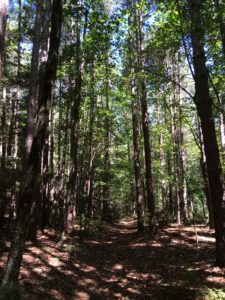The writing of this novel has been a long journey that isn’t ending with the publication of the book.
There is indeed an ending that comes with saying the writing is finished and letting it go. And there is some sadness and loss that accompanies that transition. But I am beginning to grasp that this ending is also a beginning, as you and others enter a world and meet the beloved characters that were real to me alone for so so long.
On a recent walk, I was inspired out of the blue to share some “little known facts” about the process of writing the book. Enjoy!
 1. Much, if not most, of the book was “written” on long walks in the woods.
1. Much, if not most, of the book was “written” on long walks in the woods.
This “writing” was recording. I started out with a Sony Walkman (remember those?), then moved on to a mini-cassette recorder, burning through three of them and who knows how many batteries! After filling baskets with dozens upon dozens of mini-cassettes, I graduated to various incarnations of digital recorders, until I found the perfect recording app for my iPhone. I am not a fast typist, so I have probably spent thousands of hours transcribing. Lucky I enjoy the process of editing as I do.
2. I started working on the book almost 20 years ago.
I put the writing down along the way—once for three years when my son’s special needs, moving, finances, and other work had to be my priorities. I wondered what would happen to this book. It kept calling me back to it. In all these years, I have never been bored with the novel. I consider this to be grace.
3. At one point, during my early years of intensive research for the novel, I had 109 books checked out of the UMASS library.
The internet was in its infancy. There was only one book in English about the Baal Shem Tov (that I know of), a book of legends. The copy I owned was so tattered, it was held together with rubber bands.
I needed much information to fathom and then create the world of the novel: from the cloth of Leya’s dress when she rested her hands on her knees, and what kind of floor her home had, to the roles of women, Polish and Jewish history, the illnesses of the time, transportation, food, Jewish mysticism, etc. etc. etc.
4. When I told my father, an ardent Jew, that I was writing a book about the Baal Shem Tov, he said, “Who would want to read that?
His was not a rhetorical question. No further comment.
Well, I will say that I did wonder, at times along the way, who would want to read this? But I had made a promise to write it (see Little Known Fact #11), so I would keep going, no matter what, even if I were to be the only one to ever read the book.
5. During the writing of the novel, I often felt as if I was recording what I was seeing, i.e., apprehending, rather than inventing scenes.
For example, when someone in the story would ask the Baal Shem Tov a difficult question or confront him, whether with sorrow, skepticism or hostility, I was profoundly curious about his response and would wait for him to answer. I would experience this as coming through me rather than from me. Another example: I would suddenly realize that a beloved character was going to die (not yet knowing how); I was surprised and saddened by these revelations. And when they did die, I would cry and need to pause from the writing to grieve the loss, grief that would stay with me, as it did with those in the book. I was the witness of the unfolding story, as well as its scribe.
 6. One of my most beloved places to work on the book, besides in the woods, was on the rocky coast of Maine.
6. One of my most beloved places to work on the book, besides in the woods, was on the rocky coast of Maine.
It was in a magical place called Fiddlehead in Tenants Harbor, Maine that I did my first ever solo writing retreat, my focus this book. I took a year to pay in monthly installments for a single off- season week with the ocean my constant companion. Heaven on earth. It was on a long walk in the St. George Peninsula that one of my favorite characters died, me “writing” her death, recorder in hand, crying as I did. I stopped, leaned against a tree, and wept as if I had just gotten news of the death of someone I love.
7. The Tremble of Love was once 820 pages long.
(I have witnesses.) Perhaps someday, I will share some of the outtakes.
8. While working on The Tremble of Love, I conceived of two other novels that I hope to write, given enough remaining years and a clear mind.
Both are works of historical, mystical fiction. The first, which I have named The Womb of Knowledge, is set in the 1500s in the mountaintop village of Safed in the Galilee Valley ( a place spoken of in The Tremble of Love. The other novel, The Book of Splendor, takes place during the 1300s in Spain when the Zohar, the foundational text of Jewish mysticism emerged. (These two novels must be written in a fraction of the time it took to write The Tremble of Love. Plus, they are not the only books in my queue.)
9. Among the advance readers of the novel were two individuals who had profound near death experiences.
To be clear: these experiences did not happen as a result of their reading the novel. One of these men is a much-loved minister friend who died clinically, and was “brought back,” a week before I brought him the book. The other is my plumber, who,after fixing my clogged bathroom sink, brought me to tears when telling me his heart-opening experience.
10. I typed the last words of the novel’s final draft on March 11, 2011, as the tsunami in Japan was happening.
After typing the last words of the final scene, tears rolling down my face, I wrote “The End,” knowing that I was finished. I knew that there might be revision and honing to come, but the story had been told. Within minutes, I heard/sensed the instruction: “The next time you go in, you don’t go in alone,” along with an image of me with a machete hacking away at the book. I promised inwardly that I would listen. When I went in again to refine, it would not be alone with a machete.
I don’t recall how, but within the hour I learned of the tsunami, shocking news that drained my ability to celebrate the book’s completion. I went to “downtown” Hatfield, the serene farm town where I live, and walked the sidewalks for the next two hours in the dark with a head lamp, feeling completely vulnerable and wide open—much like I had just delivered a baby—and praying for the people of Japan. I was in an altered state.
11. I started writing The Tremble Of Love in response to a most unexpected inner call.
I have shared about this with less than a handful of people. One day I may share about this inner call. A tender and vulnerable story to tell. Someday. Maybe.
For now, I will be seeking and listening for guidance about the stewarding of this book. I have realized that I am not just its author, but also its steward, at least for now. My next call: to launch it on its own journey. For it does have a life of its own.
G'Mar Chatima Tova
I close with this customary greeting whose literal meaning is: "a good final sealing." I will add to that: May you know the love of which you are made. What better than to know this?
With gratitude,
Ani
Your comments make this blog a conversation!
I would love to hear from you.
To avoid spam all comments are moderated by Ani. So if you don’t see your comment show up, not to worry; your comment will be up within within 24-48 hours





